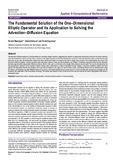The Fundamental Solution of the One Dimensional Elliptic Operator and its Application to Solving the Advection Diffusion Equation
Abstract
The advection–diffusion equation is first formulated as a boundary integral equation, suggesting the need for an appropriate fundamental solution to the elliptic operator.
Once the fundamental solution is found, then a solution to the original equation can be obtained through convolution of the fundamental solution and the desired right
hand side. In this work, the fundamental solution has been derived and tested on examples that have a known exact solution. The model problem here used is the
advection–diffusion equation, and two examples have been given, where in each case the parameters are different. The general approach is that the time derivative
has been approximated using a finite difference scheme, which in this case is a first order in ∆t, though other schemes may be used. This may be considered as the
time-discretization approach of the boundary element method. Again, where there is need for finding the domain integral, a numerical integration scheme has been
applied. The discussion involves the change in the errors with an increase in ∆x. Again, for small solution values, considering relative errors at selected points along
the domain, and how they vary with different choices of ∆x and ∆t. The results indicate that at a given value of x, errors increase with increasing ∆x, and again as R∆
increases, the magnitudes of the errors keep increasing. The stability was studied in terms of how errors from one time step do not lead to high growth of the errors in
subsequent steps.
URI
https://doi.org/10.37421/jacm.2020.9.458https://www.hilarispublisher.com/open-access/the-fundamental-solution-of-the-onedimensional-elliptic-operator-and-its-application-to-solving-the-advectiondiffusion-e.pdf
http://ir-library.mmust.ac.ke:8080/xmlui/handle/123456789/1914
Collections
- Journal Articles [411]

